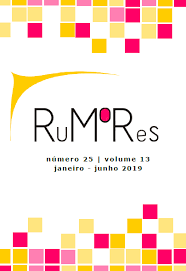The sound design of the Twin Peaks series and Alain Splet’s heritage
DOI:
https://doi.org/10.11606/issn.1982-677X.rum.2019.148627Keywords:
Twin Peaks, television, serial fiction, sound design, cinemaAbstract
This article examines the sound design of the television series Twin Peaks, created by David Lynch and Mark Frost. The focus is on the distortions or substitutions of voices, which are techniques that Lynch had used in a short and four feature-length films, with the sound designer Alan Splet. The aim is to identify any remains of Splet’s type of sound creation in the series, produced after the end of his partnership with Lynch. The analysis of the latest Twin Peaks season (2017) shows sound resources of earlier seasons have been intensified, in conjunction with the more daring plot concerning its storytelling. This article is based on Michel Chion regarding sound and on Luiz Manzano regarding sound design. James Carse’s concept of infinite game and Angela Hague’s essay on the agent Cooper’s investigative method help in understanding the relation between sound and fictional plot.
Downloads
References
BORDWELL, D. The introduction of sound. In: BORDWELL, D.; STAIGER, J.; THOMPSON, K. The classical Hollywood cinema. Nova Iorque: Columbia University Press, 1985.
CAÑIZAL, E. P. Surrealismo. In: MASCARELLO, F. (Org.). História do cinema mundial. Campinas: Papirus, 2006. p. 143-155.
CARSE, J. P. Finite and infinite games: a vision of life as play and possibility. Nova Iorque: The Free Press, 1986.
CHION, M. Audio-vision. Nova Iorque: Columbia University Press, 1994.
CHION, M. David Lynch. Barcelona: Paidós, 2003.
FELICE, F. O sonho americano de David Lynch. Imagofagia, Buenos Aires, nº 17, p. 602-610, abr. 2018.
FERRARAZ, R. O cinema limítrofe de David Lynch. 2003. Tese (Doutorado em Comunicação e Semiótica) – Pontifícia Universidade Católica de São Paulo, São Paulo, 2003.
HAGUE, A. Infinite games: the derationalization of detection in Twin Peaks. In: LAVERY, D. Full of secrets: critical approaches to Twin Peaks. Detroit: Wayne State University Press, 1995. p. 130-143.
JUNG, C. G. The archetypes and collective unconscious. Princeton: Princeton University Press, 1969.
KUZNIAR, A. Double talk in Twin Peaks. In: LAVERY, D. Full of secrets: critical approaches to Twin Peaks. Detroit: Wayne State University Press, 1995. p. 120-129.
MANZANO, L. A. Do editor de som ao sound designer, os ecos de uma evolução. Filme Cultura, Rio de Janeiro, n. 58, p. 15-19, jan.-mar. 2013.
MENDES, E. S. Entrevista 2016 C.[Entrevista cedida a] Fabiano Pereira de Souza. In: SOUZA, F. P. Alan Splet: o sound design de Veludo azul e a polifonia de efeitos sonoros. Dissertação (Mestrado em Comunicação). Universidade Anhembi Morumbi, São Paulo, 2016. p. 272-310. Disponível em: https://bit.ly/2UoJHlt. Acesso em: 28 jul. 2018.
MITTELL, J. Complex TV: the poetics of contemporary television storytelling. Nova Iorque: New York University Press, 2015.
POMMER, M. E. O tempo e o som: o inconsciente segundo Lynch e Hitchcock. In: SOCINE (Org.). Estudos de cinema Socine II e III. São Paulo: Annablume, 2000. p. 296-305.
REIS, C.; LOPES, A. C. Dicionário de teoria da narrativa. São Paulo: Ática, 1988.
RODLEY, C. Lynch on Lynch. Londres: Faber and Faber, 1997.
SODRÉ, M. O monopólio da fala: função e linguagem da televisão no Brasil. Petrópolis: Vozes, 1981.
TWIN Peaks (Temporadas 1 e 2). Direção: David Lynch et al. [S. l.]: Lynch/Frost Productions, 1990-1991. 10 DVDs (1501 min.), son., color.
TWIN Peaks. Direção: Mark Frost e David Lynch. Nova Iorque: Showtime, 2017. 18 vídeos (1025 min.), son., color.
ZETTL, H. Manual de produção de televisão. São Paulo: Cencage Learning, 2011.
Downloads
Published
Issue
Section
License
Declaro a total e irrestrita cessão de direitos autorais sobre o texto enviado para publicação na Rumores – Revista Online de Comunicação, Linguagem e Mídias. Entendo que o conteúdo do artigo é de minha inteira responsabilidade, inclusive cabendo a mim a apresentação de permissão para uso de imagens, ilustrações, tabelas, gráficos de terceiros que, porventura, venham a integrá-lo.









